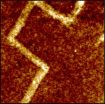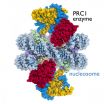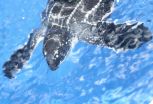(Press-News.org) VIDEO:
Nanoengineers at the University of California, San Diego recently invented a new method of lithography in which nanoscale robots swim over the surface of light-sensitive material to create complex surface...
Click here for more information.
What does it take to fabricate electronic and medical devices tinier than a fraction of a human hair? Nanoengineers at the University of California, San Diego recently invented a new method of lithography in which nanoscale robots swim over the surface of light-sensitive material to create complex surface patterns that form the sensors and electronics components on nanoscale devices. Their research, published recently in the journal Nature Communications, offers a simpler and more affordable alternative to the high cost and complexity of current state-of-the-art nanofabrication methods such as electron beam writing.
Led by distinguished nanoengineering professor and chair Joseph Wang, the team developed nanorobots, or nanomotors, that are chemically-powered, self-propelled and magnetically controlled. Their proof-of-concept study demonstrates the first nanorobot swimmers able to manipulate light for nanoscale surface patterning. The new strategy combines controlled movement with unique light-focusing or light-blocking abilities of nanoscale robots.
"All we need is these self-propelled nanorobots and UV light," said Jinxing Li, a doctoral student at the Jacobs School of Engineering and first author. "They work together like minions, moving and writing and are easily controlled by a simple magnet."
State-of-art lithography methods such as electron beam writing are used to define extremely precise surface patterns on substrates used in the manufacture of microelectronics and medical devices. These patterns form the functioning sensors and electronic components such as transistors and switches packed on today's integrated circuits. In the mid-20th century the discovery that electronic circuits could be patterned on a small silicon chip, instead of assembling independent components into a much larger "discrete circuit," revolutionized the electronics industry and set in motion device miniaturization on a scale previously unthinkable.
Today, as scientists invent devices and machines on the nanoscale, there is new interest in developing unconventional nanoscale manufacturing technologies for mass production.
Li was careful to point out that this nanomotor lithography method cannot completely replace the state-of-the-art resolution offered by an e-beam writer, for example. However, the technology provides a framework for autonomous writing of nanopatterns at a fraction of the cost and difficulty of these more complex systems, which is useful for mass production. Wang's team also demonstrated that several nanorobots can work together to create parallel surface patterns, a task that e-beam writers cannot perform.
The team developed two types of nanorobots: a spherical nanorobot made of silica that focuses the light like a near-field lens, and a rod-shape nanorobot made of metal that blocks the light. Each is self-propelled by the catalytic decomposition of hydrogen peroxide fuel solution. Two types of features are generated: trenches and ridges. When the photoresist surface is exposed to UV light, the spherical nanorobot harnesses and magnifies the light, moving along to create a trench pattern, while the rod-shape nanorobot blocks the light to build a ridge pattern.
"Like microorganisms, our nanorobots can precisely control their speed and spatial motion, and self-organize to achieve collective goals," said professor Joe Wang. His group's nanorobots offer great promise for diverse biomedical, environmental and security applications.
INFORMATION:
UC San Diego is investing heavily in robotics research while leveraging the partnership opportunities afforded by regional industry expertise in supporting fields such as defense and wireless technology, biotech and manufacturing. The Contextual Robotics Technologies International Forum was hosted by the Jacobs School of Engineering, the Qualcomm Institute and the Department of Cognitive Science.
Joe Wang is the director of the Center for Wearable Sensors at UC San Diego Jacobs School of Engineering and holds the SAIC endowed chair in engineering.
'Nanomotor lithography' answers call for affordable, simpler device manufacturing
2014-10-30
ELSE PRESS RELEASES FROM THIS DATE:
Greater inequality within UK, USA than some developing countries, trade 'footprint' shows
2014-10-30
The United States and United Kingdom buck the overall trend of developed countries having more egalitarian domestic economies than the countries they trade with.
The finding comes from the first ever 'inequality footprint' of nations, created by researchers at the University of Sydney, demonstrating the link that each country's domestic economic activity has to income distribution elsewhere in the world.
Australia, with a comparable level of international trade activity, still maintains greater internal equality than the trading nations that 42 percent of our consumption ...
Air quality and unconventional oil and gas sites
2014-10-30
Research suggesting air pollutants released by unconventional oil and gas production are well over recommended levels in the US is published today in the open access journal Environmental Health. High levels of benzene, hydrogen sulfide and formaldehyde were found. The study is the first to be based on community sampling by people who live near production sites and could be used to supplement official air-quality monitoring programs.
Unconventional oil and gas come from reserves that do not readily flow to the surface. This is because they are either distributed throughout ...
Frailty increases kidney transplant recipients' risk of dying prematurely
2014-10-30
Regardless of age, frailty is a strong risk factor for dying prematurely after a kidney transplant. The finding, which comes from a new study published in the American Journal of Transplantation, suggests that patients should be screened for frailty prior to kidney transplantation, and that those who are identified as frail should be closely monitored after the procedure.
It's very difficult for physicians to identify which patients with kidney disease will not do well after receiving a kidney transplant. Even the best models are able to correctly discriminate patients ...
Report: 93 percent of mining, oil & gas, logging, agriculture developments involve inhabited land
2014-10-30
LIMA, PERU (30 October, 2014)—In an analysis of almost 73,000 concessions in eight tropical forested countries, more than 93 percent of these developments were found to involve land inhabited by Indigenous Peoples and local communities. According to the research, conducted by The Munden Project, the total amount of land handed over by governments to the private sector for mining, logging, oil & gas drilling, and large-scale agriculture includes at least 40 percent of Peru and 30 percent of Indonesia.
"When governments sell the land, forests and other natural resources ...
More attention to measles, vaccine experts urge
2014-10-29
Doctors and public health authorities need to renew their attention to measles, researchers from Emory Vaccine Center urge in an editorial in the New England Journal of Medicine.
"Because of its high level of contagiousness, measles is the indicator disease for weaknesses of an immunization program," write Walter Orenstein, MD, and Katherine Seib, MSPH.
Orenstein is associate director of the Emory Vaccine Center and professor of medicine at Emory University School of Medicine, and Seib is research manager in Emory's Division of Infectious Diseases.
Measles is one ...
Survival rates in pediatric umbilical cord transplants may indicate a new standard of care
2014-10-29
MINNEAPOLIS-ST. PAUL (October 29, 2014) – A new standard of care for children facing acute myeloid leukemia (AML) may be clear, following a multi-year study published in the latest edition of the New England Journal of Medicine.
The research, led by John Wagner, Jr., M.D., director of the Pediatric Blood and Marrow Transplantation program at the University of Minnesota and a researcher in the Masonic Cancer Center, University of Minnesota, compared outcomes in children with acute leukemia and myelodysplastic syndrome who received transplants of either one or two ...
First detailed picture of a cancer-related cell enzyme in action on a chromosome unit
2014-10-29
A landmark study to be published in the October 30, 2014 print edition of the journal Nature provides new insight into the function of an enzyme related to the BRCA1 breast-cancer protein. The study by a team at Penn State University is the first to produce a detailed working image of an enzyme in the Polycomb Repressive Complex 1 (PRC1) -- a group that regulates cell development and is associated with many types of cancer.
Enzymes like PRC1 turn on or turn off the activity of genes in a cell by manipulating individual chromosome units called nucleosomes. "The nucleosome ...
Strong bonds with pets may help foster resiliency in military-connected children
2014-10-29
NORTH GRAFTON, Mass. Developing resiliency has important benefits for children, especially those from military families faced with significant challenges such as parental deployment and frequent moves. New research published online in Applied Developmental Science supports the idea that, along with other key resources, strong attachments to animals may help military-connected children develop resiliency and other positive developmental traits.
"We were interested in seeing if the specific stressors faced by military-connected families could be mitigated by interacting ...
'Treasure in saliva' may reveal deadly diseases early enough to treat them
2014-10-29
UCLA research could lead to a simple saliva test capable of diagnosing — at an early stage — diabetes and cancer, and perhaps neurological disorders and autoimmune diseases.
The study, the most comprehensive analysis ever conducted of RNA molecules in human saliva, reveals that saliva contains many of the same disease-revealing molecules that are contained in blood. It was published online today by the peer-reviewed journal Clinical Chemistry and will be published in the journal's January 2015 special print issue, "Molecular Diagnostics: A Revolution in Progress."
"If ...
Plump turtles swim better: First models of swimming animals
2014-10-29
MADISON, Wis. — Bigger is better, if you're a leatherback sea turtle.
For the first time, researchers at the University of Wisconsin-Madison, Florida Atlantic University (FAU), and the National Oceanic and Atmospheric Administration (NOAA) have measured the forces that act on a swimming animal and the energy the animal must expend to move through the water.
A surprising finding: Longer, slender turtles are less efficient swimmers than more rotund turtles, which get better stroke for their buck.
By taking these measurements, the research team — led by UW-Madison's ...





